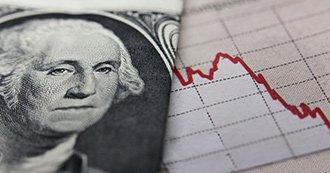July has been yet another historic month for the longest bull market on record.
The S&P 500 broke 3,000 points for the first time in history last week (July 10). And the Dow Jones Industrial Average hit an all-time high on Monday (July 15).
Even so, the stock market crash warning signs - whether from Wall Street, the Federal Reserve, or Congress - are impossible to ignore.

Growth on the S&P 500 and Dow indexes make it easy to believe Wall Street is safe. Many investors are still racing hand over fist to get in on the action.
But smart investors shouldn't get carried away.
Today, we're going to give you a closer look at why the probability of a stock market crash today could be higher than you think.
We'll also show you a way to prepare for the worst. In fact, you could even profit if the market turns completely south...
Stock Market Crash Warning Signs, No. 1: Inverted Yield Curve
Earlier this week, the New York Federal Reserve's probability model, which measures recession probabilities over the next year, hit its highest level since 2009.
Clocking in at 32.9% for the month of June, the measure had ticked up a considerable 4% since May, where it sat at around 28%.
This 4% jump has put the New York Fed on edge - every time the number has broken over the 30% mark since 1960, a recession has followed shortly after.
The central bank makes these projections largely based on the difference between 10-year and 3-month treasury bond yields. This is what it calls the "yield curve."
The Federal Reserve sees it as a stock market crash warning tremor when the value of short-term bonds starts to rise above long-term yields.
But in the little data it has on recessions, the central bank knows the yield curve has inverted before each financial crisis over 60 years.
And just last month, the treasury yield curve inverted for the first time since before the 2007 financial crisis.
Watch Now: Robert Herjavec is helping everyday Americans discover the next Airbnb. Click here now...
This means investors are buying up long-term bonds, believing future returns aren't going to be strong - that the economy may be weakening.
And the United States' bond yields aren't alone. They've been falling across the globe.
Japan, Australia, Germany, and the United Kingdom have all experienced rapidly falling bond yields over the last year.
This suggests that investors around the world are concerned that global economic growth may hit a wall.
Unfortunately, they might be on to something...
Stock Market Crash Warning Signs, No. 2: China's Economic Slowdown
According to government figures released this week, China - the world's second largest economy - suffered a significant blow to its economic output.
The report said China's gross domestic product dropped nearly 0.5% over the last quarter, down to its lowest level in over 27 years.
China has attributed this drop largely to pressure from the United States in their ongoing trade dispute.
According to Scott Minred - the global chief investment officer of Guggenheim Partners, one of the world's most successful investment firms - these trade war tensions could send stocks into free fall by the end of the year if they don't cool.
According to Minred, his firm's models suggest that "markets will make new lows in the summer" if trade tensions continue.
Even worse, Minred believes that markets are likely to fall below their December 2018 levels due to trade war tensions, a move that "would mark the end of the bull market that began in 2009."
And the White House isn't alone in setting the potential stage for the next stock market crash - Congress is also greasing the wheels for the nation's next economic catastrophe.
There's a new piece of legislation in danger of being derailed. If this happens, the next financial crisis will be worse than the last.
Here's what Congress is doing to start a market crash - and what you can do to stay ready and profitable in a downturn...
The Biggest Stock Market Crash Warning Sign
[mmpazkzone name="in-story" network="9794" site="307044" id="137008" type="4"]
On Jan. 1, 2020, a new accounting rule known as the current expected credit loss accounting standard (CECL) is scheduled to go into effect.
The rule aims to place stricter lending regulations on the nation's largest financial institutions in an effort to prevent a repeat of the 2007 financial crisis.
One of the chief impacts of this rule is that banks won't be able to rake in cash from new borrowers.
But the proposed rule is facing strong resistance from Wall Street. Lobbyists are tempting Congress to pump the breaks on letting this new rule go into effect.
There are now bills in both the House and the Senate to prevent or delay its implementation. If Congress prevents this vital economic guardrail from going into effect, it could make the next financial crisis worse than the last.
And it could make it happen sooner than you think.
While there are no certainties on Wall Street, it's always important to make sure you're prepared for the worst if the market turns south.
Thankfully, we have the perfect way to do just that...
No Place for Fear, Panic, or Mistakes: You may only have a few months to prepare. A market signal that showed up before the Great Depression... before the dot-com crash... and before the 2008 financial crisis has just appeared again. Each time this signal appears, investors only have a few short months before chaos strikes. So if you want to protect yourself and your family, there is no place for fear, panic, or mistakes. You must act now. Click here to discover how.


